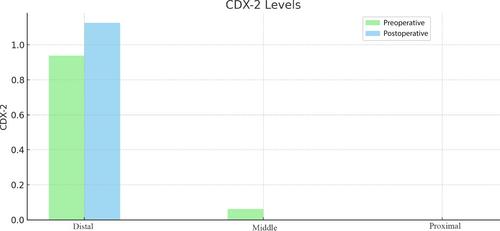One anastomosis gastric bypass (OAGB) is now the third most common bariatric surgery worldwide. This procedure is garnering increasing attention, but its complication of bile reflux and the associated risk of gastric carcinogenesis remains controversial.
The study aims to assess the impact of bile reflux on the gastric mucosa by comparing pathological and immunohistochemical results of gastric mucosa before and 2 years after OAGB surgery.
This retrospective study analyzed gastric lesions observed in gastroscopy before and after OAGB surgery. Pathological examinations were conducted on mucosal samples from proximal, middle and distal part of stomach, with a particular focus on the expression of Ki-67, P53, and CDX2 in immunohistochemistry. Ki-67 indicates cellular proliferation, P53 is a tumor suppressor protein, and CDX2 is a marker for intestinal differentiation.
A total of 16 patients completed the follow-up. Regarding gastritis, presurgery nonerosive gastritis was found in two cases (12.5%), and postsurgery in six cases (37.5%). Erosive gastritis increased from one case (6.2%) presurgery to three cases (18.7%) postsurgery, totaling an increase from three to nine cases (p = .028). Bile reflux in the stomach increased from one case (6.2%) presurgery to three cases (18.7%) postsurgery. Most lesions in the proximal, middle, and distal part of stomach were relatively mild, with normal tissue states being predominant. Mild inflammation was found in all three areas, whereas moderate inflammation, intestinal metaplasia, and glandular atrophy were less common. No cases of severe inflammation were noted. The expression of gastric biomarkers CDX-2, Ki67, and P53 showed no significant statistical variation in different areas.
Bile reflux does occur after OAGB, but its incidence is not high. Based on the immunohistochemical and pathological results of the gastric mucosa 2 years post-OAGB, there seems to be no significant causal relationship between OAGB and oncogenic inflammation around the gastric tube.



